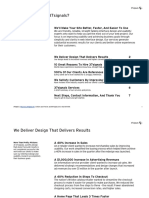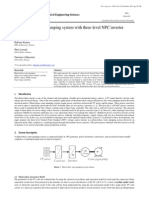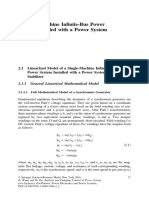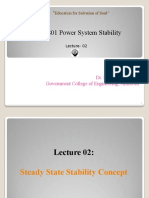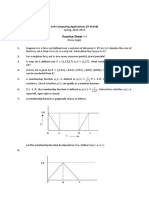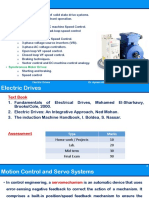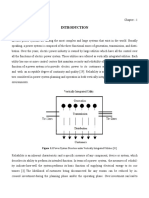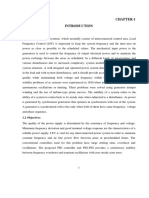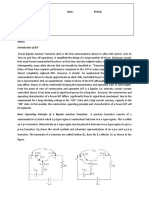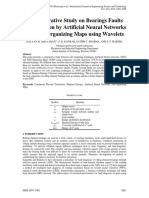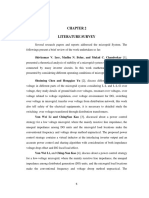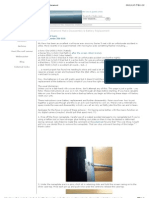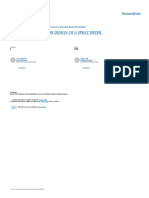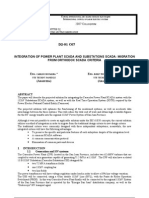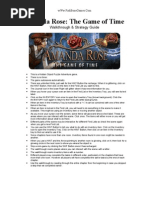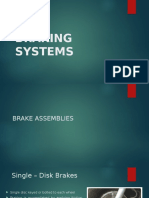Closed Loop Control of PSFB Converter
Closed Loop Control of PSFB Converter
Uploaded by
hodeegits9526Copyright:
Available Formats
Closed Loop Control of PSFB Converter
Closed Loop Control of PSFB Converter
Uploaded by
hodeegits9526Original Title
Copyright
Available Formats
Share this document
Did you find this document useful?
Is this content inappropriate?
Copyright:
Available Formats
Closed Loop Control of PSFB Converter
Closed Loop Control of PSFB Converter
Uploaded by
hodeegits9526Copyright:
Available Formats
CLOSED LOOP CONTROL OF PSFB CONVERTER
A new algorithm is proposed to implement the closed loop control of magnetically integrated
and decoupled phase shifted forward bridge dc-dc converter with a voltage doubler :
The algorithm for closed loop control is developed from the switching scheme, so first
switching scheme is discussed in fig 4.1 and fig 4.2:
(a)
b)
c)
Fig. 4.1a) magnetically integrated & decoupled PSFB dc/dc converter with voltage doubler . b) pulse generation
scheme for the switches A(S1) and B(S3).c) matlab implementation of the switching scheme
A saw tooth voltage signal is compared with a dc voltage signal Vdc base ,where the Vdc
base can change values within the limits upper and lower values as shown in the figure 4.1b),
corresponding to a movement in V
dc
base theres a phase displacement in the switching signal
switch_ A relative to switch C. Thus a given load demand is achieved by controlling the
overlap of switching pulses A and C.
State_1 is achieved by comparing saw tooth with the lower limit and the state_2 by
comparing with the V
dc
reference. The pulse are fed to an edge triggered (divide by 2 mode)
D flip-flop as clock signals, to get the switching states A and C.
Commonly used closed loop model makes the moving pulse(the pulse that makes phase
displacement) oscillate when the load demand is met at the steady state, thereby giving the
system the property of inertia with the output voltage oscillating about the reference voltage,
though within the error limits. This makes the power transfer and the flux density across the
transformer, the function of oscillating frequency, shown in fig 4.1. The conventional closed
loop control is shown in fig 4.2.
a) flux density variation vs. time
b) Detailed flux density variation at the peaks
Fig 4.2 Dependency of flux density on oscillating frequency
4.1 Conventional closed loop control for PSFB dc/dc converter
Start
Inintialize
Vdc_base
Calculate
error,e
If
e=0
Vdc_base=
current
value
K=contant, e>0
Vdc_base=ke
No
If
Vdc_lower<Vdc_base
Vdc_base=
Vdc_lower
No
If
Vdc_base<Vdc_upper
Yes
Vdc_base=
Vdc_upper
No
Yes
stop
yes
Fig 4.2 conventional closed loop control.
4.2 Proposed closed loop control for PSFB dc/dc converter
An algorithm is developed and implemented on a simulink model of PSFB converter boost
mode to mitigate this problem. The algorithm basically freezes the Vdc_base value when it
crosses the steady state value sufficient number of times.
The algorithm is shown as a flow chart in fig 4.3.
Start
Inintialize
Vdc_base
If time t< Ts
Calculate
error,e
If
Lower limit ,-
l<e<upper
limit,l
K=contant, e>0
Vdc_base=ke
No
Yes
Yes
Vdc_base=
current
value
Calculate
error,e
If
Lower limit ,-
l<e<upper
limit,l
Yes
No
If theres a change in
input voltage or
reference or load
Vdc_base=
current
value
No
K=contant, e>0
Vdc_base=ke
No
If
Vdc_lower<Vdc_base
Vdc_base=
Vdc_lower
No
If
Vdc_base<Vdc_upper
Yes
Vdc_base=
Vdc_upper
No
Yes
stop
Reset
time=0
yes
Fig 4.3 Vdc_base control algorithm
4.2.1 Explanation
The flowchart first initializes Vdc_base , then it takes care of the transient response of the
system by giving a delay in its action of time Ts, otherwise the system behavior may be
poorly read by the algorithm. After Ts the algorithm continuously updates the Vdc_base
value so that output voltage can be achieved within limits. When this is achieved the
corresponding Vdc_base value is freezed.
A safety measure is taken to stop any dynamic behavior that causes the Vdc_base values to
overshoot its limits; in that case the Vdc_base is updated to the crossed limit value till the
error is analyzed again.
A dynamic state change like change in reference, input or load will bring out the system from
its frozen state and it will start working all over again in the same way as above.
The block wise implementation on simulink is as follows,
Fig 4.4 closed loop control and pulse generation for switches A,B,C and D.
Fig 4.5 subsystem details of algorithm implementation
Fig 4.6 error estimate details
Fig 4.6 shows the logic for error estimation, whenever the error is within limits it sets the
out1=1.
Fig 4.7 Vdc_estimate details (the dynamic behavior of the system is excluded to make it simpler).
Fig 4.8 a) circuit diagram of 4-bit ripple counter b) clock cycle of counter
Whenever the error signal comes within limit it triggers the ripple counter, after eight such
crossing the fourth flip-flop is set to 1, this value is latched onto the D latch. This latching
enables Vdc_base state check to 1 which in turn latches the current value of Vdc_base.
The number of bits of the ripple counter can be increased or decreased depending upon the
response of the system.
In this whole set the algorithmic block that deals with the dynamic state change of the
system is excluded to make the implementation simpler.
Fig 4.9 Vdc_limit details
Whenever any dynamic change i.e sudden change in input, load or reference makes the
Vdc_base to cross the upper or lower limits, it sets the Vdc_base value to the last crossed
limit until the system in reset or restarted or the error calculation is within limits again.
a)
b)
Fig 4.10 flux density vs. time
4.3 Conclusions:
Closed loop control scheme is implemented for PSFB dc/dc converter.
A new control scheme is proposed and implemented on the PSFB dc/dc converter for
eliminating high frequency components in the flux density, on the matlab(simulink) platform.
You might also like
- Report Experiment 4 PvsolDocument6 pagesReport Experiment 4 PvsolAnonymous omkLUANo ratings yet
- 560AIR01 CS enDocument6 pages560AIR01 CS enUmut0% (1)
- Modeling and Control of Power ElectronicsDocument5 pagesModeling and Control of Power ElectronicsVIJAYPUTRANo ratings yet
- Creatures AppendixDocument45 pagesCreatures AppendixГарри Гаркин0% (1)
- Why Should I Hire 37signals?Document7 pagesWhy Should I Hire 37signals?AdityatejasNo ratings yet
- SMPS - Topologies PDFDocument2 pagesSMPS - Topologies PDFLungu CristianNo ratings yet
- 22 Raport FinalDocument90 pages22 Raport FinalAbidi Marwen100% (1)
- Photovoltaic Water Pumping System With Three-Level NPC InverterDocument10 pagesPhotovoltaic Water Pumping System With Three-Level NPC InverterTI Journals PublishingNo ratings yet
- CNC by SourabhDocument7 pagesCNC by SourabhsaurabhNo ratings yet
- A Single-Machine in Finite-Bus Power System Installed With A Power System StabilizerDocument64 pagesA Single-Machine in Finite-Bus Power System Installed With A Power System StabilizerAbdulbaset SlamaNo ratings yet
- MOSFET Selector Guide Definitions: Status DescriptionDocument84 pagesMOSFET Selector Guide Definitions: Status DescriptionBanyugeaNo ratings yet
- Chapter 2 Discrete Data Control SystemsDocument78 pagesChapter 2 Discrete Data Control SystemsAmruth ThelkarNo ratings yet
- EEU801 Power System Stability: Dr. Kawita D. Thakur Government College of Engineering, AmravatiDocument11 pagesEEU801 Power System Stability: Dr. Kawita D. Thakur Government College of Engineering, AmravatiSominath Harne100% (1)
- Fuzzy Logic Controller On DC/DC Boost Converter: November 2010Document7 pagesFuzzy Logic Controller On DC/DC Boost Converter: November 2010RahmadBòzNo ratings yet
- Smith McMillan FormsDocument10 pagesSmith McMillan FormsjaganathapandianNo ratings yet
- Matlab Code of GWO Minimize Constrained Objective Function PID ControllerDocument5 pagesMatlab Code of GWO Minimize Constrained Objective Function PID ControllerMerera TaresaNo ratings yet
- ECE440 MW Chapter - 3 - Transmission LineDocument70 pagesECE440 MW Chapter - 3 - Transmission Lineomar1905283No ratings yet
- Inverter Fed Induction Motor DrivesDocument2 pagesInverter Fed Induction Motor DrivesBob YahyaNo ratings yet
- Synergetic ControlDocument13 pagesSynergetic Controlrostamkola1229No ratings yet
- MPPT GwoDocument6 pagesMPPT GwoShavira AYNo ratings yet
- Hacheur MCC PDFDocument42 pagesHacheur MCC PDFskooozaNo ratings yet
- AN-1525 Single Supply Operation of The DAC0800 and DAC0802: Application ReportDocument6 pagesAN-1525 Single Supply Operation of The DAC0800 and DAC0802: Application ReportYasin ArslanNo ratings yet
- Anki A Unified Control Strategy For Three-Phase Inverter PDFDocument16 pagesAnki A Unified Control Strategy For Three-Phase Inverter PDFRavi KumarNo ratings yet
- Chapter 3Document46 pagesChapter 3Tewodros ShegawNo ratings yet
- Noureddine BOUNASLADocument296 pagesNoureddine BOUNASLASaid Zitout0% (1)
- CMOS Full Adder Circuit TopologiesDocument9 pagesCMOS Full Adder Circuit TopologiesAamodh KuthethurNo ratings yet
- Speed Control of D.C Motor With 2 Quadrant ChopperDocument4 pagesSpeed Control of D.C Motor With 2 Quadrant ChopperMechWindNaniNo ratings yet
- Report Three Phase Transmission Line FauDocument20 pagesReport Three Phase Transmission Line FauhxhokokNo ratings yet
- Unified Power Flow Controller (UPFC)Document27 pagesUnified Power Flow Controller (UPFC)mksamy2021No ratings yet
- Diagnosis of Bearing Faults Using Temporal Vibration Signals: A Comparative Study of Machine Learning Models With Feature Selection TechniquesDocument17 pagesDiagnosis of Bearing Faults Using Temporal Vibration Signals: A Comparative Study of Machine Learning Models With Feature Selection TechniquesAhmed GHORBELNo ratings yet
- AT89C51Document15 pagesAT89C51vaalginNo ratings yet
- Closed-Loop Temperature Control of An Electrical Heater: Experiment 6Document9 pagesClosed-Loop Temperature Control of An Electrical Heater: Experiment 6Trần Quốc TuấnNo ratings yet
- Dac 0800 & Dac 0802 (An 1525)Document4 pagesDac 0800 & Dac 0802 (An 1525)HARICH90No ratings yet
- How To Install Drive Cycle Support PackageDocument8 pagesHow To Install Drive Cycle Support PackageHardikNo ratings yet
- 03 - Simulation of Power Electronics Using PSIM - FinalDocument136 pages03 - Simulation of Power Electronics Using PSIM - Finalsarray rawdha100% (1)
- Single-Phase Converter Systems Containing Ideal RectifiersDocument51 pagesSingle-Phase Converter Systems Containing Ideal Rectifiersselaroth168No ratings yet
- Get Signals and Systems With MATLAB Computing and Simulink Modeling 4th Edition Steven T Karris PDF Ebook With Full Chapters NowDocument84 pagesGet Signals and Systems With MATLAB Computing and Simulink Modeling 4th Edition Steven T Karris PDF Ebook With Full Chapters Nowphoohmjahdi100% (2)
- 005 (Model-Based Fault Detection and Diagnosis)Document12 pages005 (Model-Based Fault Detection and Diagnosis)Sead KurtovićNo ratings yet
- TCSCDocument21 pagesTCSCAniruddha RayNo ratings yet
- Sparse Matrix Converter Modeling and PWM ControlDocument6 pagesSparse Matrix Converter Modeling and PWM ControlSudip MondalNo ratings yet
- Practice Sheet-I Fuzzy LogicDocument10 pagesPractice Sheet-I Fuzzy LogicShifa H RahmanNo ratings yet
- ON - Semiconductor KA78R05CTU Datasheet PDFDocument18 pagesON - Semiconductor KA78R05CTU Datasheet PDFKhaled KamelNo ratings yet
- 6 +ok+MEASURE+MENT+OF+SEQUENCE+REACTANCES+OF+SALIENT+POLE+SYNCHRONOUS+MACHINEDocument3 pages6 +ok+MEASURE+MENT+OF+SEQUENCE+REACTANCES+OF+SALIENT+POLE+SYNCHRONOUS+MACHINEaissmsNo ratings yet
- SISO Feedback LinearizationDocument24 pagesSISO Feedback LinearizationTarek Bmr100% (1)
- Mariusz - Cichowlas PWM Rectifier Active FilterDocument154 pagesMariusz - Cichowlas PWM Rectifier Active FilterJandfor Tansfg ErrottNo ratings yet
- A Comparative Study of Global Optimization PDFDocument10 pagesA Comparative Study of Global Optimization PDFSivaNo ratings yet
- Comparison of HVDC and AC TransmissionDocument2 pagesComparison of HVDC and AC Transmissionktkt24No ratings yet
- Introduction (V1)Document24 pagesIntroduction (V1)مصطفى حمدى100% (1)
- New Approach For Modelling Doubly-Fed Induction Generator (DFIG) For Grid-Connection StudiesDocument13 pagesNew Approach For Modelling Doubly-Fed Induction Generator (DFIG) For Grid-Connection StudiesKhalid HarounNo ratings yet
- ePowerControl UserManual FR V1.9Document102 pagesePowerControl UserManual FR V1.9Baz AyoubNo ratings yet
- Power TrainDocument175 pagesPower Traindpitsystems22No ratings yet
- Department of Electrical & Electronics Engg.: BEV Sem (Ex) Experiment No - 1 Aim: Apparatus RequiredDocument44 pagesDepartment of Electrical & Electronics Engg.: BEV Sem (Ex) Experiment No - 1 Aim: Apparatus Requiredvkdkris75% (4)
- CEWE Prometer - CatalogDocument2 pagesCEWE Prometer - CatalogDuy SơnNo ratings yet
- Thesis MPPTDocument64 pagesThesis MPPTGuichi OmarNo ratings yet
- AS3842Document10 pagesAS3842kik020No ratings yet
- ELEC 5565 - Electric Drives and CTRL LabDocument13 pagesELEC 5565 - Electric Drives and CTRL LabNur Azlin Mohd YusoffNo ratings yet
- C. Buck-Boost Converter Modeling D. Cuk Converter Modeling: Di V DT L TDT Qon DV V DT C RDocument6 pagesC. Buck-Boost Converter Modeling D. Cuk Converter Modeling: Di V DT L TDT Qon DV V DT C RTeja VaitlaNo ratings yet
- Multipulse Converters and Controls For HVDC and FACTS SystemsDocument9 pagesMultipulse Converters and Controls For HVDC and FACTS SystemssanjusNo ratings yet
- Sensorless Current Mode ControlDocument6 pagesSensorless Current Mode Controlsumiths32No ratings yet
- LF ACDCdemo Help V2Document2 pagesLF ACDCdemo Help V2Performance TestingNo ratings yet
- Adv Power ElectronicsDocument5 pagesAdv Power ElectronicsSumon DharaNo ratings yet
- Power Systems-On-Chip: Practical Aspects of DesignFrom EverandPower Systems-On-Chip: Practical Aspects of DesignBruno AllardNo ratings yet
- Jharokha Sep-2011Document5 pagesJharokha Sep-2011hodeegits9526No ratings yet
- SYSTEM STUDY Restructured Power SystemDocument8 pagesSYSTEM STUDY Restructured Power Systemhodeegits9526No ratings yet
- Jharokha: What Is Lokpal Bill and Why It's Important???Document4 pagesJharokha: What Is Lokpal Bill and Why It's Important???hodeegits9526No ratings yet
- Introduction Dergulated Power SystemDocument15 pagesIntroduction Dergulated Power Systemhodeegits9526No ratings yet
- Nodal Reliability and Nodal PricesDocument7 pagesNodal Reliability and Nodal Priceshodeegits9526No ratings yet
- KTG & Thermodynamics (QB)Document18 pagesKTG & Thermodynamics (QB)hodeegits9526No ratings yet
- SSribd LogyDocument47 pagesSSribd LogyTechnical S [ Technicalsufiyan ]No ratings yet
- Role of Automatic Generation Control (AGC) in Energy Management SystemDocument49 pagesRole of Automatic Generation Control (AGC) in Energy Management Systemhodeegits9526100% (1)
- Work Energy NiosDocument14 pagesWork Energy Nioshodeegits9526No ratings yet
- Harmonics Analysis of Thirteen-Level Inverter: MR - Amzad Ali, Er - Prabhat Kumar, Mr. Shiv Shanker SharmaDocument7 pagesHarmonics Analysis of Thirteen-Level Inverter: MR - Amzad Ali, Er - Prabhat Kumar, Mr. Shiv Shanker Sharmahodeegits9526No ratings yet
- Unit-I: Introduction of BJTDocument56 pagesUnit-I: Introduction of BJThodeegits9526No ratings yet
- Performance Analysis of Grid Connected Photovoltaic SystemDocument5 pagesPerformance Analysis of Grid Connected Photovoltaic Systemhodeegits9526No ratings yet
- 12th Physics II Term Test 2017 - 18Document3 pages12th Physics II Term Test 2017 - 18hodeegits9526No ratings yet
- Matlab Simulation Lab Viii SemesterDocument1 pageMatlab Simulation Lab Viii Semesterhodeegits9526No ratings yet
- Content Approximate % of TestDocument2 pagesContent Approximate % of Testhodeegits9526No ratings yet
- A Comparative Study On Bearings FaultsDocument8 pagesA Comparative Study On Bearings Faultshodeegits9526No ratings yet
- Load Flow Analysis and GA MethodDocument8 pagesLoad Flow Analysis and GA Methodhodeegits9526No ratings yet
- Literature Survey For Compensating Capacitor PlacementDocument8 pagesLiterature Survey For Compensating Capacitor Placementhodeegits9526No ratings yet
- Phase Shift Full Bridge ConverterDocument22 pagesPhase Shift Full Bridge Converterhodeegits9526100% (1)
- Microgrid System ReviewDocument6 pagesMicrogrid System Reviewhodeegits9526No ratings yet
- Psion Revo:Diamond Mako Dis Assembly & Battery ReplacementDocument9 pagesPsion Revo:Diamond Mako Dis Assembly & Battery ReplacementsalochiaoNo ratings yet
- SPM 4531 2007 Physics p2 BerjawapanDocument26 pagesSPM 4531 2007 Physics p2 Berjawapanpss smk selandar75% (4)
- MobileDocument27 pagesMobilegigglez1983No ratings yet
- Fabulously Fudgy Keto BrowniesDocument2 pagesFabulously Fudgy Keto BrowniesploesjNo ratings yet
- Preview: Personal PronounsDocument2 pagesPreview: Personal PronounsI Gusti Agung Yulia Kurmala DewiNo ratings yet
- Globalization and Its Impacts On Human Resource ManagementDocument7 pagesGlobalization and Its Impacts On Human Resource ManagementCollins UndelikwoNo ratings yet
- BUS317D - StarHub SAVED PresentationDocument21 pagesBUS317D - StarHub SAVED PresentationChattyduckyNo ratings yet
- Nara Ana Wind Power PVT - LTD: Service Inspection ReportDocument5 pagesNara Ana Wind Power PVT - LTD: Service Inspection ReportAkash RockNo ratings yet
- U1 CreatingWebsiteBasicsUsingHTMLDocument13 pagesU1 CreatingWebsiteBasicsUsingHTMLSherril VincentNo ratings yet
- Soal Uas Bhs InggrisDocument5 pagesSoal Uas Bhs Inggrisichankcnk100% (1)
- A Simple Procedure For Design Spray DryerDocument7 pagesA Simple Procedure For Design Spray DryerArielNo ratings yet
- Integration of Power Plant Scada and Substations Scada Migration From Orthodox Scada CriteriaDocument7 pagesIntegration of Power Plant Scada and Substations Scada Migration From Orthodox Scada CriteriaCarlos Alberto Di PalmaNo ratings yet
- Charith 05102021Document1 pageCharith 05102021vijithaNo ratings yet
- Amanda Rose - The Game of Time - Walk Through & Strategy Guide - WWW - fishBoneGamesDocument78 pagesAmanda Rose - The Game of Time - Walk Through & Strategy Guide - WWW - fishBoneGamesamnessiaNo ratings yet
- انجليزي السراجDocument37 pagesانجليزي السراجFuad SafadiNo ratings yet
- Habibie S RosidiDocument13 pagesHabibie S Rosidisiti munawarohNo ratings yet
- Aircraft Braking SystemsDocument14 pagesAircraft Braking SystemsLivil Lyle100% (1)
- BMW M5 Competition Specification Guide-F90.PDF.asset.1629454600709Document9 pagesBMW M5 Competition Specification Guide-F90.PDF.asset.1629454600709saboorahmad0324No ratings yet
- GCC PMC Contracting 2022 03112022Document160 pagesGCC PMC Contracting 2022 03112022KashNo ratings yet
- Go San An Cuong PDFDocument18 pagesGo San An Cuong PDFTa Thanh PhongNo ratings yet
- CMDM2023 AgendaDocument20 pagesCMDM2023 AgendauvictorNo ratings yet
- Components of Landscape DesignDocument95 pagesComponents of Landscape DesignFenil Andharia100% (1)
- 04 Bigdata HiveDocument22 pages04 Bigdata HiveRohit UppalNo ratings yet
- Croda How To LoVOCoatDocument6 pagesCroda How To LoVOCoatkarla100% (1)
- Acad Dermatol Venereol - 2018 - Wollenberg - Consensus Based European Guidelines For Treatment of Atopic Eczema AtopicDocument26 pagesAcad Dermatol Venereol - 2018 - Wollenberg - Consensus Based European Guidelines For Treatment of Atopic Eczema Atopicmaituuyen1997No ratings yet
- Control Units Group2Document22 pagesControl Units Group2Mudassar IqbalNo ratings yet
- Hungarian Insolvency Act Act Xlix of 1991 2019Document136 pagesHungarian Insolvency Act Act Xlix of 1991 2019Bálint FodorNo ratings yet




